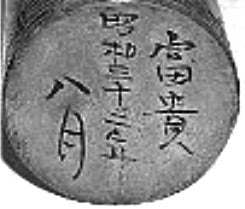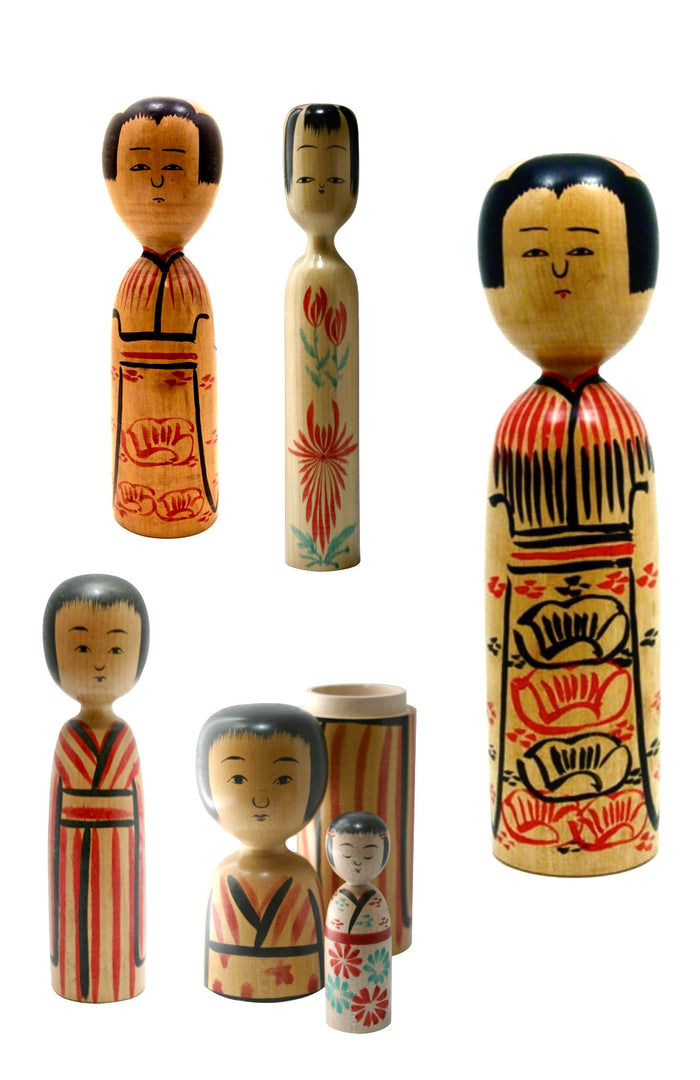

Antique Japanese Kijiyama Transitional Kokeshi by Yoshashi Takani
Dimensions: 14-0”h
Yoshashi-san was born in 1907 in Niigata Prefecture. He studied Japanese painting after the war and initially was a Kimono yuzen artist focused on the rare “teak yuen” involving approximately twenty processes including conceptualizing the design and creating detailed colored drawings as the central motif. He later decided to produce a Yohachi doll (Kokeshi) incorporating the yuzen technology in the town of Kawazure which was originally established in the 17th century during the Edo period. He passed away in 1994 in Saitama City (former Urawa).
The majority of his dolls focused on Kimono art and cherished Yuzen resist dyeing incorporated into textile art which utilized a dyeing technique characterized by beautiful designs featuring subjects from nature, including flowers and mountains, as well as animal and human figures. As with the figure offered his representation of this form of freehand drawing and painting. Very little is known about this artist although he accomplished several beautiful painted dolls during his lifetime. His work broke from the traditional Kijiyama motif and became renowned for its distinct and vivid colors.
Condition: Excellent and has retained the original craft/workmanship.

Japanese Traditional Kokeshi
Kijiyama-Kei (Family)
Prefecture: Akita
Origin:
One of the most readily recognizable traditional dolls is the Kijiyama type, from the region of the same name in the Akita Prefecture. The name is derived from the wood craftsmen (Kiji-ya), who live in the remote mountains of the Tohoku region. The actual location of Kijiyama is so remote that it was inaccessible in the harsh winter months. Many of the kokeshi makers left and settled in the less remote areas of Kawazura, now part of Inagawa-machi. Some suggest that the dignified, lonely look on the faces of Kiiyama kokeshi reflects the lonesome past of their birthplace.
Collector's note – characteristics / painting style:
Despite the slightly sad look some of these kokeshi have, they are very appealing and sought after for their well-defined style. Their elongated “inverted egg” shaped head is attached to a relatively chunky body, both of which are well proportioned. They typically have a red hair ribbon-like motif, but some can be without any hair ribbon (Okappa style), with a “bobbed” hairstyle and half or full moon bangs across the forehead. The eyes can be shut or partially closed (tsubushi-me), or fully opened, and may or may not have eyebrows. Their nose shapes are typically rounded, with small single or double-line lips. The most common motif on the body incorporates chrysanthemums, which were common in the earlier versions. Plum blossoms are seen on those dolls, which are closely associated with the Ogura family. The body usually possesses a kimono-like painted design in several distinctive patterns, suggesting an apron (maedare), over the kimono, which was incorporated later in the doll's development. Additionally, a striped overall patterned kimono-clad is seen as an alternative to the apron. Some have what is called a Kasuri pattern using a kanji symbol. Most Kijiyama dolls demonstrate the same state of being within this style of Kokeshi.

Leading Craftsmen:
Abe, Heishiro, 1929-2013, (Inagawa, Akita) - Master: Takahashi, Heijiro. No additional published information
Abe, Yoko, 1932, (Yuzaya, Akita) - Master: Abe, Heishiro. No additional published information
Honma, Isao, 1935. The third son of Shimazo and Rio Honma is a schoolteacher in Tsubakigawa, Higashinaruse Village, Ogachi District, and Akita Prefecture. His family owned forestland, so he loved woodworking from elementary school, making wooden carvings including Kokeshi, bears, and furniture. No additional published information.
Igawa, Takemitsu, 1925-2008, (Inagawa Akita) - Master: Ozeki, Kyutaro. No additional published information.
Kitayama, Kenichi - No additional published information
Koyasu, Ichigoro - No additional published information
Onodera, Masanori, 1948-2018. Kijiyama lineage, Master: Tokuichi Onodera. The eldest son of Onodera Tokuichi in Odate, Kawatsuraya, Akita Prefecture. The Onodera family had been lacquer artists in Kawatsuraya for generations. It is said that Fujimi (childhood name Umetaro), who was a lacquer artist, innovated the painting and decorating Kokeshi dolls and started the painting method of apron. After graduating from the Yuzawa Kita branch school, Masanori worked as a lacquer artist for two years and then studied woodworking for one year. He learned lathe working from his father Tokuichi. No additional published information.
Ogura, Kyutaro, 1906-1998, Grand Master (Minase, Akita) - Master: Ogura, Kyushiro. No additional published information
Ogura, Tomezo, 1909, (Inagawa, Akita) - Master Ogura, Kyushiro. No additional published information
Onodera, Juichi, 1908, (Inagawa, Akita) - Master Ogura, Keitaro. No additional published information
Sato, Hideichi, 1927, (Inagawa, Akta), Master Sato, Kaneichi. No additional published information
Shibata, Ryoji, 1944, (Inagawa, Akita)) - Master Shibata, Tetsuzo. The second son of Keijiro Ogura and Mura in Yafumae, Odate, Kawatsurē Village, Akita Prefecture, and in 1958, at the age of 15, he made a Kijiyama doll which influenced his lifetime profession throughout his life. No additional published information is available.
Suzuki, Koutaro, 1922-1989, (Inagawa, Akita) - Master Takahashi, Heijiro. No other published information.
Takahashi, Yuji, 1934 - No additional published information.
Explore & Learn More about Kijiyama-Kei (Family)